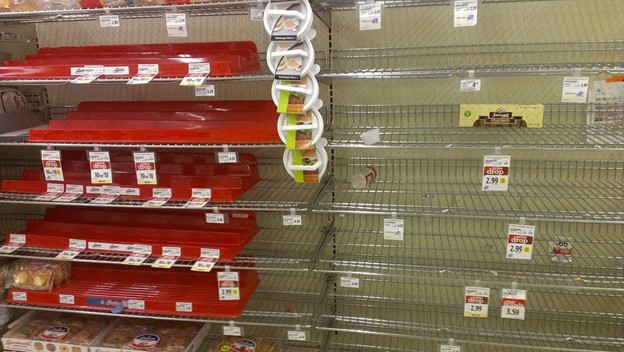The first COVID-19 was reported in Malaysia on January 25, and the virus has been spreading since then, causing more than 21 350 infections and 190 deaths.
The pandemic has spread across the world, causing many nations to impose rigorous lockdown, close factories, and restaurants, in addition to international travel restrictions. These measures were geared toward limiting the spread of coronavirus, which also affected different aspects of the economy.
One of the severely affected areas is the food security and supply chains both locally and at the global level. The disruption led to higher food prices, empty shelves in the supermarkets, and millions of employees lost their employment.
The article will tell you more about how the COVID-19 interrupted the food supply.

The Disruption of Food Supply by the Pandemic
When the first case was announced in China, followed by other nations, governments responded by announcing containment measures that limited people and goods’ movement.
The initial reaction was panic buying since people were ordered to stay indoors, cook, and eat at home to ensure social isolation. The outcome was a high demand for food items at supermarkets and local markets.
On the other hand, the lockdown and restricted international travel disrupted the supply of labour and inputs in the manufacturing and agriculture industries.
The outcome is interference with food security, which is generally multidimensional in nature. It involves factors such as food accessibility, availability, and utilization. Therefore the current pandemic directly impacts the food supply chain and food security because it has increased the demand, yet there is a limited supply of food items.
The outcome of the COVID-19 crisis is changed consumer behaviour, and reduced ability to produce and distribute food in the country, affecting the vulnerable and poor members of the society.
The Extent of Food Supply Disruption by COVID-19
The food supply chain is a network of different activities ranging from production to processing to distribution to retailing and, lastly consumption.
Although Malaysia didn\’t experience a shock in the food supply, the country reported several cases of disruptions of food transport. These are food supplies that require more human interaction and several tiers of suppliers. The interruptions affected nutritious food more than the staples as well as imports.
Effects on Food Supply
COVID-19 safety measures encouraged social isolation to limit the spread of coronavirus from one person to the other. That meant that people should stay or work from home and always maintain social distancing and wear a mask when in public places.
For that reason, most factories closed or reduced the number of workers, thus less production. Further, transport restrictions and road closures prevented farmers and producers from supplying their commodities to the market or accessing inputs. The outcome was reduced production and revenues.
For instance, the agriculture sector relies on foreign workers; thus, the lockdown measures led to a shortage of workers in the labour-intensive food production sectors. The outcome is reduced food availability and higher market prices.
The supply of perishable and fresh produce has experienced a huge loss since the start of the pandemic due to reduced labour and transport. This has led to increased food waste and post-harvest losses.

Other sectors, like seafood, experienced a huge decline in both supply and demand for aquatic products. Factors such as limited opening hours resulting from lockdown and limited sales operation due to reduced labour and transportation led to a sudden decline of fresh fish.
Restaurants were ordered to remain closed except for takeaways, causing many wholesalers to stop buying and distributing fresh aquatic products. Fishers are also reluctant to go fishing, thus affecting the communities that rely on the fishing business.
The same situation is experienced in the local production of chicken and beef because of the reduction of operating hours in retail centres and eateries.
The Effects on Food Demand
One common response to the COVID-19 pandemic across the world was the increased purchase of food items. The increased demand for food commodities and changes in dietary patterns led to empty shelves in the supermarkets.
More so, the significant rise had an inflationary effect, and food prices rose. For instance, lower-income families allocate a higher part of their earnings on food, and a rise in prices, no matter how temporary it is, affects them significantly. Therefore countries that depend on food imports experienced greater signs of anxiety that led to panic buying to minimize social unrest.
The Outcome of Food Supply Disruption
COVID-19 pandemic is still spread globally, and people are still demonstrating concerns over food supply due to disruptions of food supply chains.
Nations are responding to this disruption by banning exports of their staple foods to meet their domestic demand and alleviate shortages.
Vietnam is the third-largest rice exporter globally and has reacted to COVID-19 by reducing its rice exports to shore up its domestic supplies. India and Myanmar also reduced their supply, which has contributed to the increased demand for rice.
Thailand can’t satisfy the increased demand for rice, resulting from cut overseas sales by other exporters. This situation will lead to a global food supply crisis if it remains unchecked. Malaysia imports its rice from Cambodia, India, Myanmar, Pakistan, Thailand, Vietnam, and others. Thus, the country may deplete its emergency stockpiles if the coronavirus crisis persists and when various countries adopt more stringent containment measures that Malaysia imports its food from.
Measures to Maintain Food Supply during the Pandemic
Support Farmers: Farmers are not able to access markets to sell their produce or buy inputs due to restrictions on movements. Thus, the government should implement stimulus packages to support small-scale farmers, thus reducing post-harvest losses and increasing food availability across the country.
Embrace Digital Solutions: These are input and labor-saving practices. Digital technologies can connect producers to buyers and logistic services, thus minimizing food supply chain disruptions during the crisis.
E-commerce: Most producers are using e-commerce platforms to sell their products. However, agribusiness has not embraced these platforms fully; thus, farmers are not able to access a larger pool of consumers during the pandemic.
Price Control: Monitoring the markets and food prices will protect both the producers and consumers. Information should be disseminated promptly to prevent public panic, which can lead to social unrest.
Takeaway
COVID-19 has significantly disrupted food supply locally and globally. It’s still unclear how long this crisis will last since more cases are being reported in the country and across the world.
Thus farmers and manufacturers are not able to access the markets fully while the consumers are experiencing higher prices and reduced food availability and affordability.
However, government intervention will stabilize the food supply chain, shielding both the producer and consumer against higher food and input prices.








